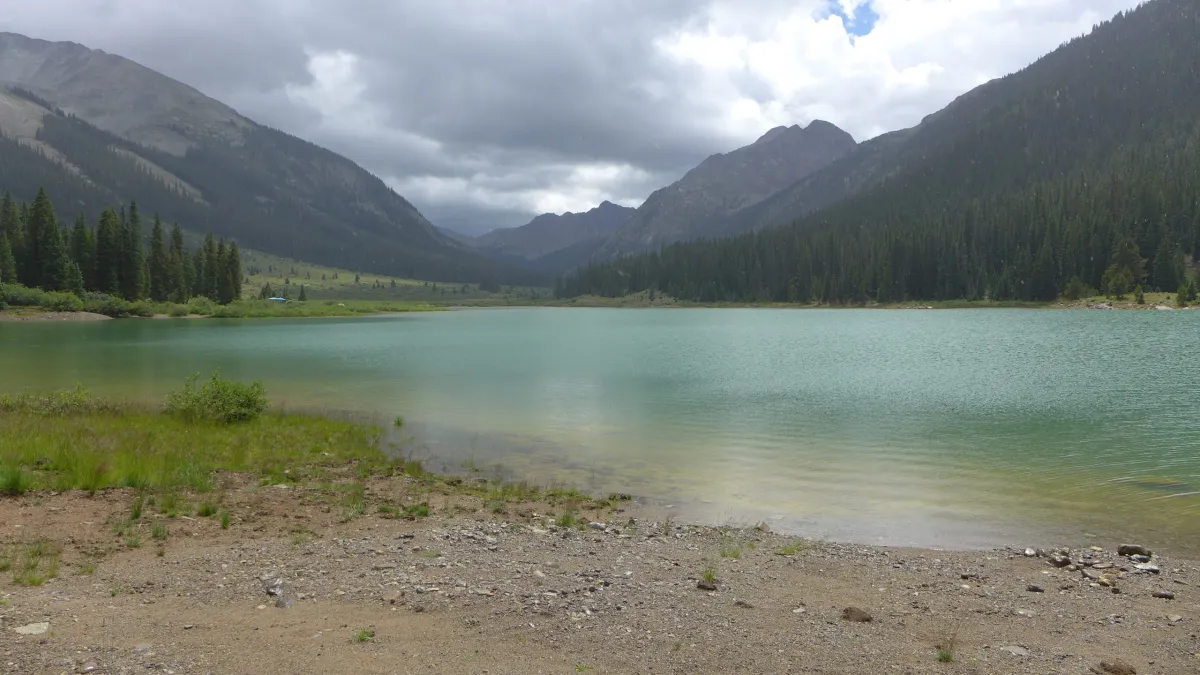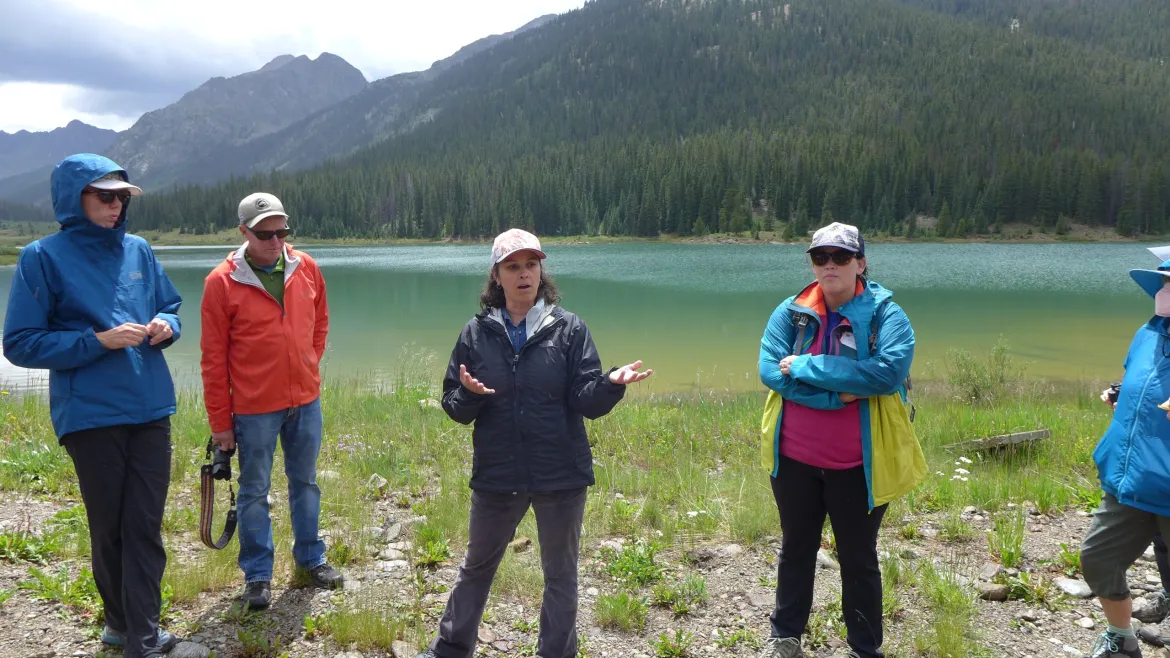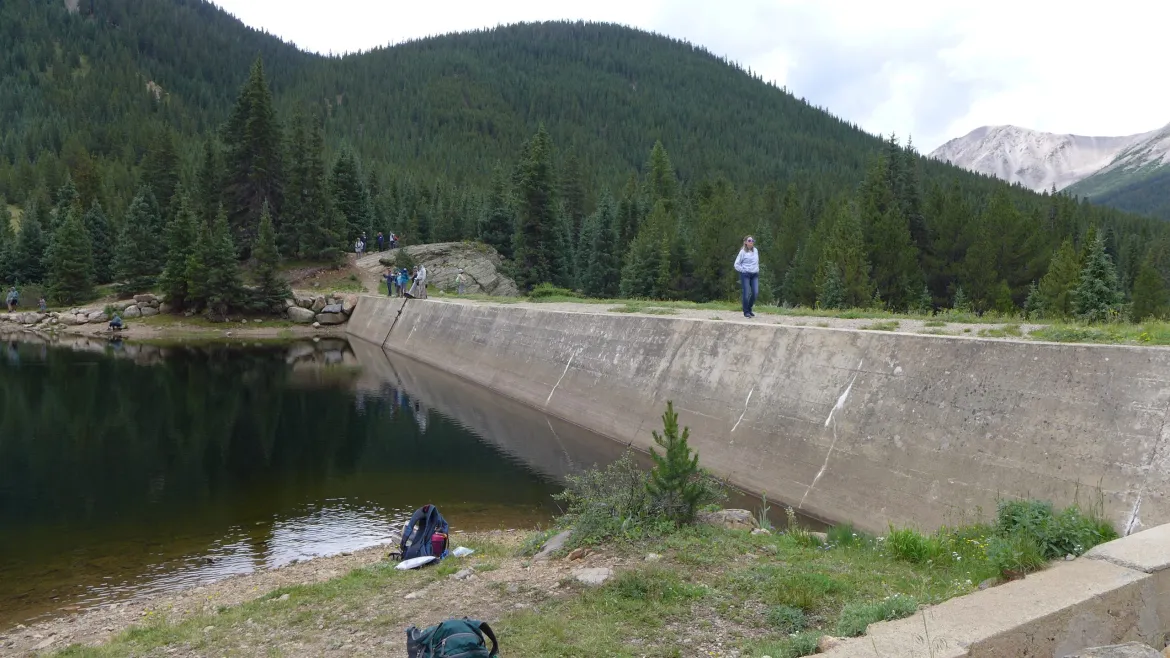
Grizzly Reservoir, the high-mountain lake above Aspen formed by damming Lincoln and Grizzly creeks, will be drained next summer for repairs to the dam, tunnel and outlet works.
After spring runoff next year, Twin Lakes Reservoir and Canal Company will draw down the reservoir so workers can install a membrane over the steel face of the dam, which was constructed in 1932 and is corroded and thinning, according to a May report on the feasibility of the dam rehabilitation.
The report, by RJH Consultants, Inc. of Englewood, included an inspection and evaluation of the infrastructure, and presented different options for rehabilitation. Half the cost of the study — $50,000 — was funded by the Colorado Water Conservation Board.
The project will also replace the gates that control the flow of water into the Twin Lakes Tunnel and repair the outlet works that release water down Lincoln Creek. According to the report, the outlet works have issues with cracks, holes and seepage, and the more-than-80-year-old tunnel gates have problems with leakage, are difficult to operate and require significant maintenance every year.
“The purpose of the rehabilitation of the dam is to address dam safety concerns associated with the corroded and thinning upstream-slope steel facing, uncontrolled seepage, and operational problems with the outlet works,” the report reads.
Twin Lakes officials expect the project to be completed in October 2023. They will also draw down the reservoir this month to weld a small test portion of the dam membrane to see how it fairs through the harsh winter at 10,500 feet. That work is scheduled to begin Aug. 22 and the reservoir will be refilled in October.
“That infrastructure is aging and it’s time to do some rehab work on it,” said Twin Lakes Reservoir and Canal Company Board President Kalsoum Abbasi.
Grizzly Dam is considered a high hazard dam by the Division of Water Resources. That does not mean it’s likely to fail, but it means loss of life would be expected if the dam did fail. The last state inspection in 2021 found the dam satisfactory — the highest rating — and said full storage capacity was safe.
The report estimated a nearly $7 million price tag for the rehabilitation work. Twin Lakes plans to get a CWCB loan for some of the cost and will pay the remainder with money raised from assessments on its water users.

Twin Lakes system
Grizzly Reservoir is part of a complex system of storage buckets, tunnels and canals that takes water from the headwaters of the Roaring Fork River basin under the continental divide and delivers it to Front Range cities. The system collects runoff from 45 square miles of mountainous terrain, including the New York, Brooklyn, Tabor, Lincoln, Grizzly and Lost Man creek drainages and dumps it into Grizzly Reservoir, which can hold 570 acre-feet of water.
From there the water flows into the 4-mile-long and straight-as-a-pin Twin Lakes Tunnel under the Continental Divide and into Lake Creek, a tributary of the Arkansas River. Twelve miles later the water arrives at the Twin Lakes Reservoir where it is stored before being sent to Front Range cities via pipelines and pumps.
Four municipalities own 95% of the shares of Twin Lakes water: Colorado Springs Utilities owns 55%; the Board of Water Works of Pueblo has 23%; Pueblo West Metropolitan District owns 12% and the City of Aurora has 5%.
The Twin Lakes system is so integral to the cities’ water supply that they employ two caretakers to live year-round in a cabin at the remote reservoir site to make sure everything operates smoothly. It’s Colorado Springs’ largest source of Western Slope water and represents about 21% of its total water supply.
The project is able to divert up to 46,000 acre-feet annually, or nearly 40% of the flows in the Roaring Fork headwaters, according to numbers from the Roaring Fork Conservancy. In recent years, Twin Lakes has diverted between about 31,000 and 38,000 acre-feet annually, according to data from the Colorado Division of Water Resources.
During next year’s rehabilitation work most of the creeks — Lost Man, New York, Brooklyn and Tabor — will be allowed to flow downstream instead of being collected by a canal system that feeds Grizzly Reservoir. As long as the water rights are in priority, Twin Lakes will probably still take and send through the tunnel whatever flows they get from Lincoln and Grizzly creeks, according to Abbasi. This means a stretch of Lincoln Creek below the dam will be dry.
When irrigators in the Grand Valley place the Cameo call, which happens most summers and often commands the entire Colorado River and its tributaries upstream, those with junior water rights have to stop diverting so irrigators can get their share. That’s because under Colorado water law the oldest water rights have first use of the river and Cameo’s right is older than Twin Lakes’.
“As long as we are in priority, we can still bring some water through the tunnel,” Abbasi said. “Whatever is making it into the reservoir, we will have a way to route that through the tunnel for the majority of the project.”
Abbasi said overall, Twin Lakes will probably divert less water than normal in 2023.

Pitkin County’s stored water
Once work begins on the dam next summer, there will probably be more water flowing in the upper Roaring Fork above Aspen when the creeks that usually flow into Grizzly are allowed to go downstream. But there will also be a 200-acre-foot hole where water stored by Pitkin County won’t be released.
As part of a 2018 water court settlement, Pitkin County received 800 to 1,000 acre-feet of water from the Twin Lakes system, which is sent downstream instead of to the Front Range. Two hundred acre-feet of that can be stored in Grizzly Reservoir to release during the late summer.
“The rationale for Pitkin pushing for that was that’s when we tend to need the water the most,” said Laura Makar, assistant Pitkin County Attorney. “That’s when flows matter and every cfs makes the biggest difference.”
This year, the county used the 200 acre-feet to help boost streamflows between the end of spring runoff and when the Cameo call came on this week.
“We timed it perfectly so there’s no hole in the river,” Makar said. “The fish and river got the full benefit. We could sort of nurse the river along until the Cameo call came on.”
But next year, releasing the 200 acre-feet of stored water won’t be possible since there won’t be any water in Grizzly Reservoir during the late summer.
“It sounds like next year we will be limited to whatever exists naturally in the system,” Makar said. “We are making sure that when we plan for next year, we are ensuring we get the full benefit… but knowing we won’t have 200 acre-feet in late season releases that could actually come from the reservoir.”
Aspen Journalism covers rivers and water in collaboration with The Aspen Times. This story ran in the Aug. 14 edition of The Aspen Times.
The Water Desk’s mission is to increase the volume, depth and power of journalism connected to Western water issues. We’re an initiative of the Center for Environmental Journalism at the University of Colorado Boulder. The Water Desk launched in April 2019 with support from the Walton Family Foundation. We maintain a strict editorial firewall between our funders and our journalism.





